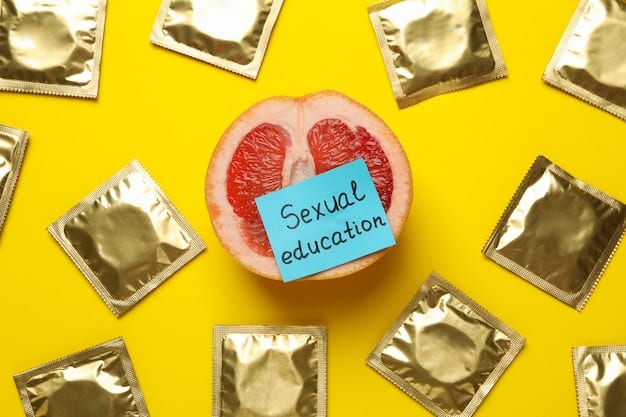Understanding the Risks of Untreated STIs: Prevention and Early Detection Guide

Understanding the Risks of Untreated STIs: A Guide to Prevention and Early Detection is crucial for maintaining sexual health and preventing long-term complications. Early detection and treatment are vital to protect yourself and your partners from potential health issues.
Sexually transmitted infections (STIs) are a significant public health concern, affecting millions worldwide. Understanding the Risks of Untreated STIs: A Guide to Prevention and Early Detection is essential because many STIs can be asymptomatic, meaning you might not know you have one. This guide aims to shed light on the potential dangers of ignoring these infections and provides actionable steps for prevention and early detection.
Understanding the Risks of Untreated STIs: A Guide to Prevention and Early Detection
Sexually transmitted infections (STIs) can have serious health consequences if left untreated. It’s important to be aware of the risks to protect yourself and your partners. This section will explore the potential health implications of untreated STIs.
Long-Term Health Consequences
Ignoring STIs can lead to a variety of long-term health problems. Some of the most significant risks include:
- Pelvic Inflammatory Disease (PID): This can result from untreated chlamydia or gonorrhea in women, leading to chronic pelvic pain, ectopic pregnancy, and infertility.
- Infertility: STIs like chlamydia and gonorrhea can damage the reproductive organs in both men and women, making it difficult to conceive.
- Increased Risk of HIV: Having an STI, particularly one that causes sores or inflammation, can increase the risk of contracting HIV during sexual contact.
- Pregnancy Complications: Untreated STIs in pregnant women can lead to premature birth, low birth weight, and transmission of the infection to the baby.
Specific STI Risks
Different STIs pose unique threats if not addressed promptly:
- Chlamydia: Can cause PID in women and epididymitis in men, leading to infertility.
- Gonorrhea: Similar to chlamydia, it can lead to PID and infertility.
- Syphilis: If untreated, it can progress through stages, eventually affecting the brain, heart, and other organs.
- HPV: Certain strains can cause cervical cancer and other cancers.
Understanding these risks is the first step in taking proactive measures to protect your health. Early detection and treatment can prevent many of these complications from occurring.
The Importance of Early STI Detection
Early detection of STIs is critical for preventing the spread of infection and mitigating potential health complications. Many STIs are asymptomatic, making regular testing essential.

Why Early Detection Matters
Detecting STIs early offers several key benefits:
- Prevents Transmission: Identifying and treating STIs reduces the risk of spreading the infection to sexual partners.
- Reduces Health Risks: Early treatment can prevent long-term complications such as infertility, PID, and organ damage.
- Enables Timely Treatment: Many STIs are easily treatable with antibiotics or antiviral medications when caught early.
- Improves Overall Health: Addressing STIs promptly can improve overall sexual and reproductive health.
Methods for Early Detection
Several methods are available for detecting STIs early:
- Regular Testing: Routine STI screenings are recommended for sexually active individuals, especially those with multiple partners.
- Symptom Awareness: Being aware of common STI symptoms, such as unusual discharge, sores, or pain during urination, can prompt early testing.
- Partner Notification: If you test positive for an STI, informing your sexual partners allows them to get tested and treated, preventing further spread.
Incorporating these practices into your routine can significantly reduce the impact of STIs on your health and the health of others. Taking charge of your sexual health through early detection is a responsible and proactive approach.
Prevention Strategies for STIs
Preventing STIs involves adopting safe sexual practices and taking proactive steps to minimize risk. This section will explore effective prevention strategies that everyone can implement.
Safe Sexual Practices
Adopting safe sexual practices is the cornerstone of STI prevention:
- Consistent Condom Use: Using condoms correctly and consistently during sexual activity significantly reduces the risk of STI transmission.
- Limiting Sexual Partners: Reducing the number of sexual partners decreases the likelihood of exposure to STIs.
- Open Communication: Talking openly with your partners about sexual history and STI status is crucial for making informed decisions.
Vaccination
Vaccines are available for some STIs, providing effective protection:
- HPV Vaccine: Recommended for adolescents and young adults, the HPV vaccine protects against strains that can cause genital warts and certain cancers.
- Hepatitis B Vaccine: This vaccine protects against hepatitis B, a viral infection that can be transmitted through sexual contact.
Other Preventive Measures
In addition to safe practices and vaccination, consider these measures:
- Regular Testing: Even with safe practices, regular STI testing is important, especially if you have multiple partners or engage in high-risk behavior.
- Avoid Sharing Personal Items: Do not share items such as razors or toothbrushes, which can transmit certain infections.
By integrating these prevention strategies into your lifestyle, you can greatly reduce your risk of contracting and spreading STIs. Remember, proactive prevention is the best defense against these infections.

Understanding the Risks of Untreated STIs: A Guide to Prevention and Early Detection in Specific Populations
Certain populations may face unique challenges or higher risks related to STIs. Understanding these specific considerations is essential for tailored prevention and care.
Adolescents and Young Adults
Adolescents and young adults are disproportionately affected by STIs for several reasons:
- Lack of Awareness: Limited knowledge about STIs and safe sexual practices can increase risk.
- Multiple Partners: Young people may have multiple sexual partners, heightening their exposure to infections.
- Reluctance to Seek Care: Fear of judgment or lack of access to healthcare can prevent young people from getting tested and treated.
To address these challenges, comprehensive sex education, accessible testing services, and confidential healthcare are crucial.
Pregnant Women
STIs in pregnant women can have severe consequences for both the mother and the baby:
- Transmission to Newborn: STIs can be transmitted to the baby during pregnancy, labor, or delivery, leading to serious health problems.
- Pregnancy Complications: Untreated STIs can cause premature birth, low birth weight, and even stillbirth.
Routine STI screening during pregnancy is essential to identify and treat infections early, protecting both the mother and the child.
Men Who Have Sex with Men (MSM)
MSM are at higher risk for certain STIs, including HIV and syphilis:
- High-Risk Behaviors: Certain sexual practices can increase the risk of STI transmission.
- Lack of Awareness: Insufficient knowledge about safe sex practices can contribute to higher infection rates.
Targeted prevention efforts, including regular testing, condom promotion, and access to pre-exposure prophylaxis (PrEP) for HIV, are vital for reducing STI rates in this population.
Addressing the specific needs and challenges of these populations requires tailored approaches that promote awareness, access to care, and safe sexual practices.
Navigating STI Testing and Treatment
Getting tested and treated for STIs is a straightforward process that can significantly improve your health and prevent further transmission. This section provides a guide to navigating STI testing and treatment options.
Where to Get Tested
Various healthcare providers and facilities offer STI testing:
- Primary Care Physicians: Your family doctor can perform STI screenings during routine check-ups.
- Health Clinics: Many health clinics offer confidential and affordable STI testing services.
- Planned Parenthood: Planned Parenthood provides comprehensive sexual and reproductive health services, including STI testing and treatment.
- Online Testing Services: Some companies offer discreet at-home STI testing kits with mail-in results.
What to Expect During Testing
The testing process typically involves:
- Consultation: A healthcare provider will discuss your sexual history and risk factors.
- Sample Collection: Depending on the STI, samples may be collected through urine, blood, or swab.
- Results: Test results are usually available within a few days to a week.
Treatment Options
Most STIs are treatable with medication:
- Antibiotics: Bacterial STIs like chlamydia, gonorrhea, and syphilis are typically treated with antibiotics.
- Antiviral Medications: Viral STIs like herpes and HIV can be managed with antiviral medications.
It’s crucial to follow your healthcare provider’s instructions carefully and complete the full course of treatment to ensure the infection is cleared. Understanding the Risks of Untreated STIs: A Guide to Prevention and Early Detection also includes seeking prompt medical attention if you suspect you have an STI.
By understanding your testing options and available treatments, you can take control of your sexual health and prevent the spread of STIs.
| Key Point | Brief Description |
|---|---|
| ⚠️ Long-Term Risks | Untreated STIs can lead to PID, infertility, and increased HIV risk. |
| 🔎 Early Detection | Regular testing and symptom awareness are crucial for early STI detection. |
| 🛡️ Prevention | Safe practices, vaccines, and limiting partners reduce STI risk. |
| 🩺 Testing & Treatment | Testing is available at clinics, and most STIs are treatable with medication. |
Frequently Asked Questions
Untreated STIs can lead to severe health problems, including pelvic inflammatory disease, infertility, increased risk of HIV, and pregnancy complications. Early treatment is essential to avoid these issues.
The frequency of STI testing depends on your sexual activity and risk factors. Sexually active individuals with multiple partners should get tested every 3-6 months, while others should test annually.
While condoms significantly reduce the risk of STI transmission, they are not 100% effective. Consistent and correct use is crucial, but regular testing is still recommended for sexually active individuals. Understanding the Risks of Untreated STIs: A Guide to Prevention and Early Detection includes practicing safe sex.
Many STIs are asymptomatic, but common symptoms include unusual discharge, sores, itching, pain during urination, and pelvic pain. If you experience any of these symptoms, seek medical attention.
Yes, vaccines are available for HPV and Hepatitis B, which are sexually transmitted. The HPV vaccine is recommended for adolescents and young adults, while the Hepatitis B vaccine is available for individuals of all ages.
Conclusion
Understanding the Risks of Untreated STIs: A Guide to Prevention and Early Detection empowers individuals to take control of their sexual health. By prioritizing prevention, early detection, and prompt treatment, you can protect yourself and your partners from the potential consequences of STIs.





